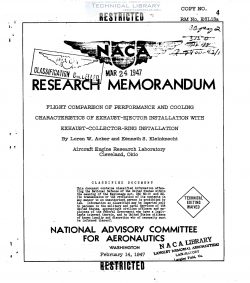naca-rm-e6l13a
- Version
- 121 Downloads
- 1.20 MB File Size
- 1 File Count
- April 21, 2017 Create Date
- April 21, 2017 Last Updated
National Advisory Committee for Aeronautics, Research Memorandum - Flight Comparison of Performance and Cooling Characteristics of Exhaust-Ejector Installation with Exhaust Collector Ring Installation

Flight and.ground investigations have been made to compare
an exhaust-ejector installation with a standard exhaust—collector-
ring installation on air-cooled aircraft engines in a twin—engine
airplane. The ground investigation showed that, whereas the
standard.engine would have overheated above 600 horsepower, the
engine with exhaust eJectors cooled at take-off operating condi-
tions at zero ram. The exhaust ejectors provided as much cooling
with cowl flaps closed as the conventional cowl flaps induced when
full open at low airspeeds. The propulsive thrust of the exhaust-
eJector installation was calculated to be slightly less than the
thrust of the collector-ring installation.
As part of a program requested by the Bureau of Aeronautics,
Navy Department, flight and ground investigations have been made
on an exhaust-ejector installation in a twin-engine airplane. The
exhaust ejectors were designed to increase the cooling-air flow
through the engine and were installed in the left nacelle. The
right engine was left in its standard configuration with an exhaust
collector ring. The cooling-air pressure drop across the engine
and the cylinder temperatures were measured in each installation
to determine the improvement in engine cooling obtained with the
exhaust ejectors. Brake horsepower and exhaust back pressure were
measured for each installation to compare the over-all performance.
A JM—l airplane (serial No. 4lr3554l) (fig. 1) equipped with two
3-2800-45 engines was used in the investigation. The 3-2800-45 engine
has a normal power rating of 1600 horsepower at a speed of 2400 rpm
and a manifold pressure of 41 inches of mercury absolute; it has a
military takevoff rating of 2000 horsepower at 2700 rpm and 52 inches
of mercury absolute. The left nacelle was modified by replacing the
conventional exhaust-collector-ring installation with an exhaust-
eJector installation (figs. 2 and 5). No modifications were made on
the right nacelle (figs. 4 and 5).
| File | Action |
|---|---|
| naca-rm-e6l13a Flight Comparison of Performance and Cooling Characteristics of Exhaust-Ejector Installation with Exhaust Collector Ring Installation .pdf | Download |

Comment On This Post